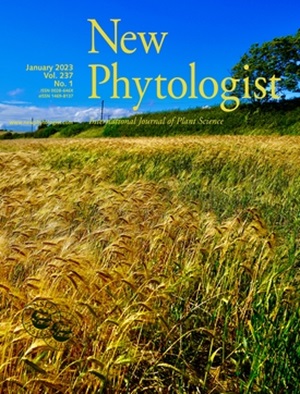SHOT GLASS, an R2R3-MYB transcription factor, promotes gemma cup and gametangiophore development in Marchantia polymorpha.
IF 8.1
1区 生物学
Q1 PLANT SCIENCES
引用次数: 0
Abstract
Many plants reproduce asexually by generating clonal progeny from vegetative tissues, a process known as vegetative reproduction. This reproduction mode contrasts with sexual reproduction, which enhances genetic diversity. The bryophyte Marchantia polymorpha L. adjusts its reproductive strategy in response to seasonal environmental cues, transitioning between vegetative and sexual reproduction. In this study, we identified a gene encoding the R2R3-MYB transcription factor SHOT GLASS (MpSTG) as a critical regulator of gemma cup development. MpSTG was predominantly expressed in the gemma cup, apical notch, and sexual reproductive organs (gametangiophores). MpSTG mutation resulted in the formation of abnormal shot-glass-shaped structures lacking gemmae, which replaced functional gemma cups. Additionally, MpSTG-disrupted plants failed to develop sexual reproductive organs, even under inductive conditions. In Arabidopsis thaliana, the MpSTG ortholog LATERAL ORGAN FUSION1 (AtLOF1) plays a pivotal role in lateral bud formation. We demonstrated that MpSTG can partially compensate for AtLOF1's function in lateral bud formation in A. thaliana. Our findings suggest that MpSTG is a key regulator of vegetative and sexual reproduction in M. polymorpha, and illustrate that evolutionarily conserved developmental mechanisms may function in both the gametophyte generation of bryophytes and the sporophyte generation of angiosperms.SHOT GLASS是一种R2R3-MYB转录因子,可促进多形地豆(Marchantia polymorpha)的gemma cup和配子体的发育。
许多植物通过无性繁殖从营养组织产生无性繁殖后代,这一过程被称为营养繁殖。这种繁殖方式与有性繁殖形成对比,增强了遗传多样性。苔藓植物多形地豆(Marchantia polymorpha L.)根据季节环境因素调整其繁殖策略,在营养繁殖和有性繁殖之间过渡。在这项研究中,我们发现了一个编码R2R3-MYB转录因子SHOT GLASS (MpSTG)的基因,它是gemma杯发育的关键调节因子。MpSTG主要在胚芽杯、根尖缺口和性生殖器官(配子管)中表达。MpSTG突变导致异常的短玻璃状结构的形成,缺乏gemma,取代了功能性的gemma杯。此外,mpstg中断的植物即使在诱导条件下也不能发育出有性生殖器官。在拟南芥中,MpSTG同源侧体器官融合1 (AtLOF1)在侧芽形成中起关键作用。我们证明MpSTG可以部分补偿AtLOF1在拟南芥侧芽形成中的功能。我们的研究结果表明,MpSTG是多形植物营养生殖和有性生殖的关键调节因子,并说明进化上保守的发育机制可能在苔藓植物配子体和被子植物孢子体的产生中都起作用。
本文章由计算机程序翻译,如有差异,请以英文原文为准。
求助全文
约1分钟内获得全文
求助全文
来源期刊

New Phytologist
生物-植物科学
自引率
5.30%
发文量
728
期刊介绍:
New Phytologist is an international electronic journal published 24 times a year. It is owned by the New Phytologist Foundation, a non-profit-making charitable organization dedicated to promoting plant science. The journal publishes excellent, novel, rigorous, and timely research and scholarship in plant science and its applications. The articles cover topics in five sections: Physiology & Development, Environment, Interaction, Evolution, and Transformative Plant Biotechnology. These sections encompass intracellular processes, global environmental change, and encourage cross-disciplinary approaches. The journal recognizes the use of techniques from molecular and cell biology, functional genomics, modeling, and system-based approaches in plant science. Abstracting and Indexing Information for New Phytologist includes Academic Search, AgBiotech News & Information, Agroforestry Abstracts, Biochemistry & Biophysics Citation Index, Botanical Pesticides, CAB Abstracts®, Environment Index, Global Health, and Plant Breeding Abstracts, and others.
 求助内容:
求助内容: 应助结果提醒方式:
应助结果提醒方式:


